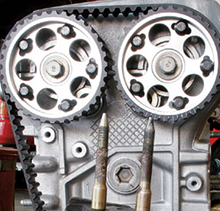 The timing belt is the notched rubber belt, which is sometimes called a Gilmer belt. This belt allows the crankshaft to drive the camshaft, which in turn opens and closes the valves. Without this belt, the engine can’t run.
The timing belt is the notched rubber belt, which is sometimes called a Gilmer belt. This belt allows the crankshaft to drive the camshaft, which in turn opens and closes the valves. Without this belt, the engine can’t run.
During the inspection, your Import Master technican will look for signs of wear, such as cracks, shredding or excessive slack. We will also look for signs of oil leaks from the adjacent seals, which can damage the belt and considerably shorten its life.
Many modern cars have interference engines, or motor wreckers, as we in the trade refer to them. If a timing belt breaks or jumps a notch in an interference engine, the valves may open at the wrong time and then be struck by the pistons. The result will be many hundreds of dollars in damage to your engine. Be sure to ask us if your vehicle has an interference engine. If you don’t have an interference engine, a broken timing belt will leave you stranded — which is inconvenient — but won’t do any permanent damage.
All cars have ways to adjust the timing belt tension. Some cars have self-adjusting mechanisms, while others need to be adjusted manually.
Checking your timing belt for wear or looseness will let you know if the belt may likely break soon or if it may possibly jump a notch. If you don’t periodically inspect your timing belt, it might break at an inopportune moment.
Timing Belt FAQs
What happens if I don't check my timing belt?
This break in the timing belt could cause valves to bend or break as well as damage the head itself; pistons could also become damaged in the process.



